Do you have a question about the La Crosse Technology WS9090 and is the answer not in the manual?
Describes the 868MHz Temperature Station, its ease of use, and Instant Transmission+ technology.
Lists features like DCF-77 time, 12/24hr format, calendar, time zone, temperature units, MIN/MAX records, and wireless transmission.
Describes the transmitter's function, casing, and recommended mounting.
Step-by-step guide for inserting batteries into the transmitter and station for initial setup.
Instructions for installing and replacing batteries in the main temperature station unit.
Instructions for installing and replacing batteries in the outdoor temperature transmitter.
Provides advice on regular battery replacement for accuracy and environmental disposal.
Explains the functions of the SET key for manual settings and resetting MIN/MAX records.
Details the MIN/MAX/+ key's use for adjustments and toggling temperature readings.
Describes the first section of the LCD showing time, calendar, and signal reception status.
Describes the second section of the LCD showing indoor and outdoor temperatures and indicators.
Explains the Cesium Atomic Clock, transmission, range, and how the station receives the DCF-77 signal.
Provides tips on improving DCF-77 signal reception by managing distance and avoiding interference.
Guide to manually setting the time when DCF-77 reception is not possible.
Instructions for manually setting the date (day, month, year) and weekday.
How to select between 12-hour and 24-hour time display formats.
How to set the time zone for the station, with options from -12 to +12 hours.
How to disable the radio-controlled time reception if it is not possible in the area.
How to switch the temperature display between Celsius (°C) and Fahrenheit (°F).
How to view the minimum and maximum indoor and outdoor temperatures recorded.
Instructions on how to reset both the indoor and outdoor MIN/MAX temperature records.
How to interpret the low battery indicator on the LCD for battery replacement.
Notes that cold temperatures may decrease the transmitting distance of the outdoor unit.
Lists common issues and checks for poor 868 MHz signal reception, like interference and distance.
Advice against opening battery covers after signal reception to prevent false resets.
Discusses the 100m transmission range and factors affecting it, suggesting resets if needed.
Guidance on choosing a sheltered location and mounting the temperature station on a wall.
How to place the temperature station on any flat surface using its foldout stand.
Instructions for wall mounting the transmitter bracket and clipping the sensor, or placing it on a surface.
Avoid extreme temperatures, vibration, and shock; handle batteries with care; clean with a damp cloth.
Do not submerge, handle damaged LCDs carefully, do not attempt repairs, avoid exposed circuits.
Notes that sudden temperature changes can affect forecast accuracy and readings.
Details the indoor and outdoor temperature measuring ranges and resolution in Celsius and Fahrenheit.
Lists power consumption, checking intervals, battery types, and unit dimensions.
Instructions on proper electronic waste disposal and importance of reading the user manual.
States manufacturer non-responsibility for incorrect readings and limits product use to home indication.
Information on R&TTE Directive compliance and statement of conformity for wireless transmission.
Describes the 868MHz Temperature Station, its ease of use, and Instant Transmission+ technology.
Lists features like DCF-77 time, 12/24hr format, calendar, time zone, temperature units, MIN/MAX records, and wireless transmission.
Describes the transmitter's function, casing, and recommended mounting.
Step-by-step guide for inserting batteries into the transmitter and station for initial setup.
Instructions for installing and replacing batteries in the main temperature station unit.
Instructions for installing and replacing batteries in the outdoor temperature transmitter.
Provides advice on regular battery replacement for accuracy and environmental disposal.
Explains the functions of the SET key for manual settings and resetting MIN/MAX records.
Details the MIN/MAX/+ key's use for adjustments and toggling temperature readings.
Describes the first section of the LCD showing time, calendar, and signal reception status.
Describes the second section of the LCD showing indoor and outdoor temperatures and indicators.
Explains the Cesium Atomic Clock, transmission, range, and how the station receives the DCF-77 signal.
Provides tips on improving DCF-77 signal reception by managing distance and avoiding interference.
Guide to manually setting the time when DCF-77 reception is not possible.
Instructions for manually setting the date (day, month, year) and weekday.
How to select between 12-hour and 24-hour time display formats.
How to set the time zone for the station, with options from -12 to +12 hours.
How to disable the radio-controlled time reception if it is not possible in the area.
How to switch the temperature display between Celsius (°C) and Fahrenheit (°F).
How to view the minimum and maximum indoor and outdoor temperatures recorded.
Instructions on how to reset both the indoor and outdoor MIN/MAX temperature records.
How to interpret the low battery indicator on the LCD for battery replacement.
Notes that cold temperatures may decrease the transmitting distance of the outdoor unit.
Lists common issues and checks for poor 868 MHz signal reception, like interference and distance.
Advice against opening battery covers after signal reception to prevent false resets.
Discusses the 100m transmission range and factors affecting it, suggesting resets if needed.
Guidance on choosing a sheltered location and mounting the temperature station on a wall.
How to place the temperature station on any flat surface using its foldout stand.
Instructions for wall mounting the transmitter bracket and clipping the sensor, or placing it on a surface.
Avoid extreme temperatures, vibration, and shock; handle batteries with care; clean with a damp cloth.
Do not submerge, handle damaged LCDs carefully, do not attempt repairs, avoid exposed circuits.
Notes that sudden temperature changes can affect forecast accuracy and readings.
Details the indoor and outdoor temperature measuring ranges and resolution in Celsius and Fahrenheit.
Lists power consumption, checking intervals, battery types, and unit dimensions.
Instructions on proper electronic waste disposal and importance of reading the user manual.
States manufacturer non-responsibility for incorrect readings and limits product use to home indication.
Information on R&TTE Directive compliance and statement of conformity for wireless transmission.
| Display Type | LCD |
|---|---|
| Outdoor Temperature Range | -40°F to 140°F (-40°C to 60°C) |
| Humidity Range | 10% to 99% |
| Rainfall Range | 0 to 393.7 inches (0 to 9999 mm) |
| Power (Display) | 3 x AA batteries (not included) |
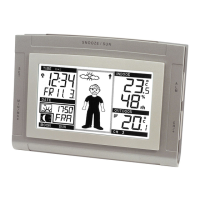
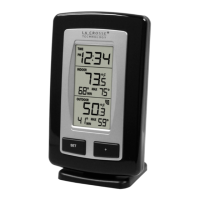


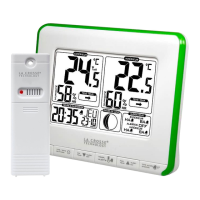

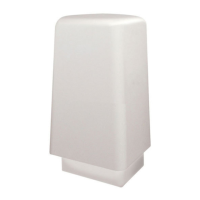



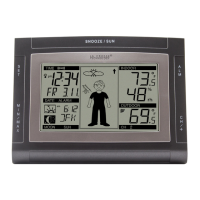
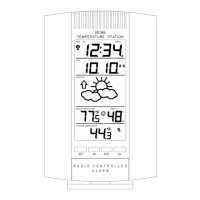
